Lexus IS250 IS220d GSE20 ALE20 2AD-FHV STARTING
STARTER - INSPECTION
| 1. INSPECT STARTER ASSEMBLY |
- NOTICE:
- Make sure to complete following each test within 5 seconds to prevent the coil from burning out.
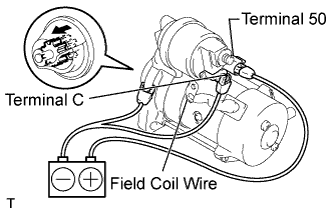
Perform pull-in test:
Disconnect the field coil wire from terminal C.
Connect the battery to the magnetic switch as shown in the illustration. Check that the clutch pinion gear moves outward.
If the clutch pinion gear does not move outward, replace the repair service starter kit.
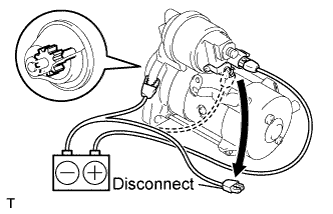
Perform hold-in test:
Disconnect the negative (-) terminal lead from terminal C under conditions for pull-in test. Check that the pinion gear rear remains out.
If the clutch pinion gear moves inward, replace the repair service starter kit.
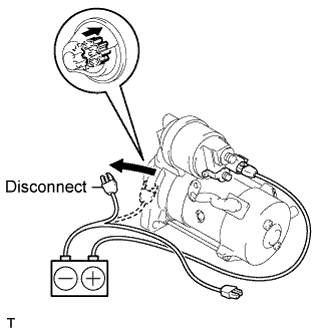
Inspect clutch pinion gear return:
Disconnect the negative (-) lead from the starter body. Check that the clutch pinion gear moves inward.
If the clutch pinion gear does not move inward, replace the repair service starter kit.
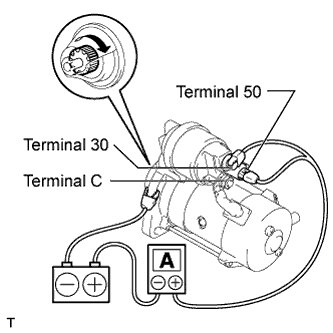
Perform no-load performance test:
Connect the field coil wire to terminal C with the nut. Make sure that the lead is not grounded.
- Torque:
- 5.9 N*m{ 60 kgf*cm, 52 in.*lbf}
Clamp the starter in a vise.
Connect the battery and an ammeter to the starter as shown in the illustration.
Check that the starter rotates smoothly and steadily with the clutch pinion gear remaining out. Check that the ammeter reads the specified current.
- Specified current:
Condition Specified condition at 11.5 V 190 A or less
If the current is not as specified, overhaul the starter assembly.
| 2. INSPECT STARTER ARMATURE ASSEMBLY |
Inspect the resistance of the commutator.
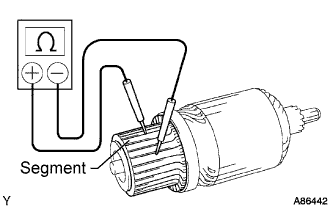
Using an ohmmeter, measure the resistance between the segments of the commutator.
- Standard resistance:
Tester connection Specified condition Segment - Segment Below 1 Ω
If the resistance is not as specified, replace the armature assembly.
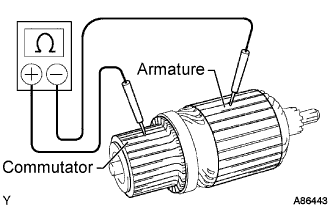
Using an ohmmeter, measure the resistance between the commutator and armature coil core.
- Standard resistance:
Tester connection Specified condition Commutator - Armature coil core 10 kΩ or higher
If the resistance is not as specified, replace the armature assembly.
Check the surface of the commutator for dirt or burn.
If the surface is dirty or burnt, smooth it with 400-grit sandpaper or trim it on a lathe.
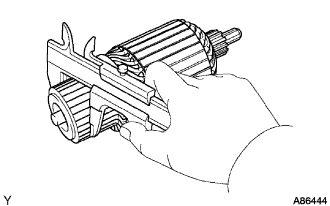
Using vernier calipers, measure the commutator diameter.
- Standard diameter:
- 35.0 mm (1.378 in.)
- Minimum diameter:
- 34.0 mm (1.339 in.)
If the diameter is less than the minimum, replace the armature.
Using a dial indicator, measure the commutator's runout.
- Maximum commutator's runout:
- 0.05 mm (0.0020 in.)
If commutator's runout is greater than the maximum, correct it using a lathe.
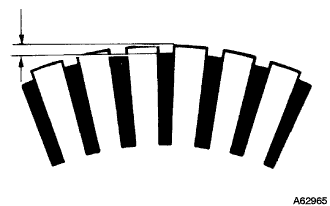
Check that the undercut depth is clean and free of foreign materials. Smooth out the edge.
- Standard undercut depth:
- 0.6 mm (0.024 in.)
- Minimum undercut depth:
- 0.2 mm (0.008 in.)
If the undercut depth is less than the minimum, increase the depth using a hacksaw blade.
| 3. INSPECT STARTER YOKE ASSEMBLY |
Inspect for an open circuit.
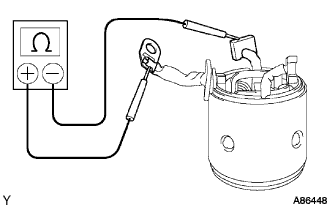
Using an ohmmeter, measure the resistance between the terminal C wire and brushes.
- Standard resistance:
Tester connection Specified condition Terminal C wire - Brushes Below 1 Ω
If the resistance is not as specified, replace the starter yoke assembly.
Inspect for a short circuit.
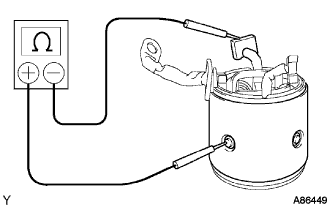
Using an ohmmeter, measure the resistance between the brushes and starter yoke body.
- Standard resistance:
Tester connection Specified condition Brushes - Starter yoke body 10 kΩ or higher
If the resistance is not as specified, replace the yoke assembly.
| 4. INSPECT BRUSH |
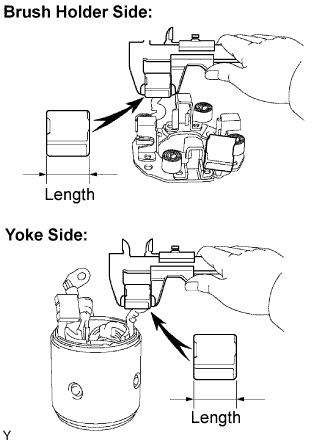
Using vernier calipers, measure the brush length.
- Standard length:
- 15.5 mm (0.610 in.)
- Minimum length:
- 10.0 mm (0.394 in.)
If the brush length is less than the minimum, replace the brush holder and yoke assembly.
| 5. INSPECT STARTER BRUSH HOLDER ASSEMBLY |
Inspect the resistance.
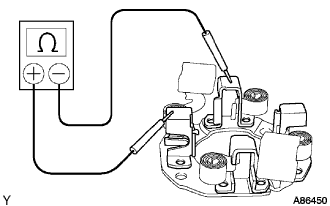
Using an ohmmeter, measure the resistance between the positive (+) and negative (-) brush holders.
- Standard resistance:
Tester connection Specified condition Positive (+) brush - Negative (-) brush 10 kΩ or higher
If the resistance is not as specified, replace the brush holder.
Inspect the load of the brush spring.
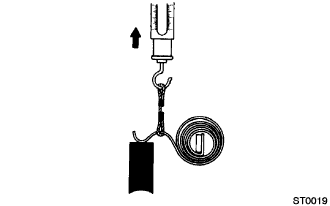
Take the pull scale reading immediately after the brush spring separates from the brush.
- Standard spring installed load:
- 23.5 to 29.5 N (2.4 to 3.0 kgf, 5.3 to 6.6 lbf)
If the installed load is not as specified, replace the brush holder.
| 6. INSPECT STARTER CENTER BEARING CLUTCH SUB-ASSEMBLY |
Check the gear teeth of the planetary gear and starter center bearing clutch for wear or damage.
If any planetary gear is damaged, replace the planetary gear assembly.
If any gear of the starter center bearing clutch is damaged, replace the clutch.
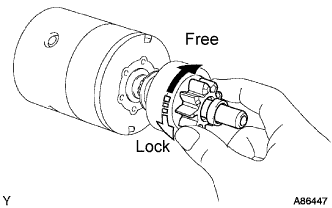
Check the movement of the clutch pinion gear.
Rotate the clutch pinion gear clockwise, and check that it turns freely.
Try to rotate the clutch pinion gear counterclockwise, and check that it locks.
If the clutch pinion gear cannot be turned clockwise smoothly, or does not lock in the counterclockwise direction, replace the starter clutch.
| 7. INSPECT REPAIR SERVICE STARTER KIT |
Inspect the resistance of the pull-in coil.
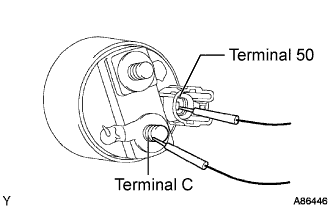
Using an ohmmeter, measure the resistance between terminals 50 and C.
- Standard resistance:
Tester connection Specified condition Terminal 50 - Terminal C Below 1 Ω
If the resistance is not as specified, replace the repair service starter kit.
Inspect the resistance of the hold-in coil.
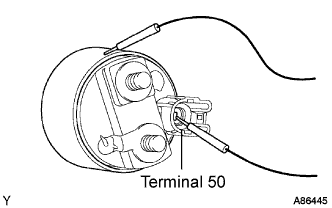
Using an ohmmeter, measure the resistance between terminal 50 and the switch body.
- Standard resistance:
Tester connection Specified condition Terminal 50 - Switch body Below 1.5 Ω
If the resistance is not as specified, replace the repair service starter kit.